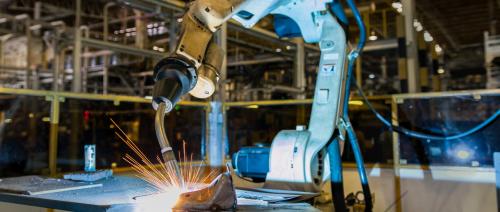What Are the Types and Application Areas of Automatic Welding Robots?

In modern welding production, due to the complexity of the process and the higher and higher requirements for welding quality, it is more and more difficult to find welding workers. Welding robots can well complete various welding tasks. The use of robots for automated welding also plays a very important role in improving the accuracy and quality of welding products and shortening the processing time. According to the welding process, welding robots can be divided into spot welding robots, arc welding robots, friction stir welding robots, laser welding robots and other types.
1. Spot welding robot
The spot welding robot has the characteristics of large payload and large working space. It is equipped with a dedicated spot welding gun and can realize flexible and accurate movement to meet the requirements of spot welding operations. Its most typical application is the automatic assembly of automobile bodies. production line. When assembling each car body, a large part of the solder joints is completed by robots. But when the spot welding robot first appeared, it was only used to enhance the welding operation. Later, for the purpose of splicing accuracy, it began to complete the positioning welding operation.

2. Arc welding robot
Arc welding robots are widely used in many industries, such as general machinery and metal structures. The arc welding robot is a flexible welding system, including various arc welding accessories, not just a machine that carries the welding torch at a predetermined speed and posture, so its performance has special requirements. In the arc welding operation, the welding torch should track the movement of the weld of the workpiece and continuously fill with metal to form the weld. Therefore, speed stability and trajectory accuracy are two important indicators in the movement process.
3. Friction stir welding robot
Friction stir welding robot provides positive pressure, torque, and force sensing of the robot due to the vibration generated during the welding process, the pressure applied to the weld, the size of the stirring spindle, the vertical and lateral trajectory deflection, etc. Ability, trajectory control ability, etc. have put forward higher requirements.
4. Laser welding robot
In addition to higher accuracy requirements, laser welding robots often cooperate with linear axes, rotating tables or other robots to achieve flexible welding of complex curved welds or large weldments.
At this stage, welding robots have achieved good results in industrial production, especially in automobiles, ships and other manufacturing industries. They are also widely used in machinery manufacturing, electronic equipment, aerospace, construction and so on. In the future, its development in artificial intelligence is the main research direction, and optimizing its structure and function to improve its work efficiency is bound to be another new breakthrough for the development of human industry. For more information about welding robot and its application cases, please visit this page.
Advertise on APSense
This advertising space is available.
Post Your Ad Here
Post Your Ad Here
Comments